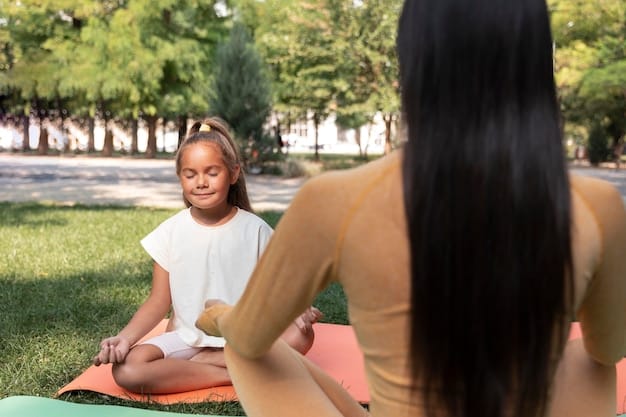Transcendental Meditation: Your 2025 Guide to Inner Peace

Transcendental Meditation (TM) is a simple, natural, and effortless technique practiced for 20 minutes twice daily to promote deep relaxation, reduce stress, and enhance overall well-being, especially relevant in the fast-paced world of 2025.
In the hustle and bustle of modern life, finding moments of peace can seem like an impossible task. But what if there was a simple, accessible technique that could help you achieve inner calm and clarity? Enter Transcendental Meditation: A Comprehensive Guide to Achieving Inner Peace in 2025 and discover how it can revolutionize your well-being.
Understanding Transcendental Meditation
Transcendental Meditation (TM) is a specific form of mantra meditation that originated in India. Unlike other forms of meditation that may require concentration or control of the mind, TM involves the effortless use of a mantra to settle the mind and promote deep relaxation.
The Origins of TM
Developed by Maharishi Mahesh Yogi in the mid-1950s, Transcendental Meditation has gained widespread popularity due to its simplicity and effectiveness. Maharishi Mahesh Yogi introduced TM to the West, making it accessible to people from all walks of life.
How TM Differs From Other Meditation Techniques
One key difference lies in the effortlessness of TM. Practitioners don’t need to concentrate, control their thoughts, or force their minds to be quiet. Instead, they gently use a mantra, allowing the mind to settle naturally.
- Effortless technique without concentration.
- Use of a personalized mantra.
- Promotes deep relaxation.
- Suitable for individuals of all backgrounds.
In essence, Transcendental Meditation offers a way to tap into a state of restful alertness, fostering mental clarity and reducing stress without rigorous mental exercises. This makes it an appealing option for those seeking inner peace in today’s demanding world.
The Core Principles of Transcendental Meditation
At the heart of Transcendental Meditation lie several core principles that make it a unique and effective practice. Understanding these principles can help you appreciate the benefits and approach TM with the right mindset.
The Role of the Mantra
A mantra in TM is a specific sound or word chosen for its ability to quiet the mind. Each practitioner receives a personalized mantra from a certified TM teacher, ensuring that the mantra resonates with their individual needs.
Effortless Practice
TM is designed to be effortless. The aim is not to stop thoughts, but rather to allow the mind to settle naturally. This ease of practice is one of the reasons why TM is so accessible and sustainable for many people.

The power of Transcendental Meditation lies in its simplicity and naturalness. By understanding these principles, you can approach TM with a sense of ease and openness, allowing yourself to experience its profound benefits.
Benefits of Transcendental Meditation in 2025
In 2025, the benefits of Transcendental Meditation (TM) extend beyond simple relaxation. With increased stress and the rapid pace of modern life, TM offers a wealth of advantages for mental, physical, and emotional well-being.
Mental Health Improvements
TM has been shown to reduce symptoms of anxiety, depression, and PTSD. Regular practice can lead to a more balanced emotional state and improved overall mental health.
Physical Health Benefits
Studies have indicated that TM can lower blood pressure, reduce the risk of heart disease, and improve sleep quality. These physical benefits contribute to a stronger, healthier body.
Enhanced Cognitive Function
Practicing TM can enhance cognitive functions such as memory, focus, and creativity. This can lead to increased productivity, better decision-making, and a sharper mind.
- Reduced stress and anxiety levels.
- Improved cardiovascular health.
- Better sleep quality and reduced insomnia.
- Increased focus and cognitive function.
Transcendental Meditation offers a holistic approach to wellness, addressing both the mind and body. In 2025, these benefits are more crucial than ever for maintaining a balanced and fulfilling life.
How to Learn Transcendental Meditation
Learning Transcendental Meditation involves a specific process that ensures you are properly trained and can practice the technique effectively. Here’s a breakdown of how to get started with TM.
Finding a Certified TM Teacher
The first step is to find a certified Transcendental Meditation teacher. Certified teachers have undergone extensive training and are qualified to provide personalized instruction and support.
The TM Course
The TM course typically involves several sessions over a few days. During the course, you will learn the theory behind TM, receive your personal mantra, and be guided through the initial meditation sessions.
Personalized Instruction
One of the key aspects of learning TM is personalized instruction. Your teacher will work with you to ensure that you understand the technique and can practice it correctly.

Learning Transcendental Meditation is an investment in your well-being. By following these steps and seeking guidance from a certified teacher, you can embark on a journey towards greater inner peace and fulfillment.
Integrating Transcendental Meditation Into Your Daily Routine
Once you’ve learned Transcendental Meditation, the next step is to seamlessly integrate it into your daily routine. Consistency is key to experiencing the full benefits of TM.
Setting Aside Time
Ideally, you should practice TM for 20 minutes twice a day – once in the morning and once in the late afternoon or early evening. Find times that work best for you and stick to them as much as possible.
Creating a Peaceful Environment
Choose a quiet, comfortable place where you can meditate without being disturbed. It could be a dedicated meditation room, a cozy corner in your living room, or even a peaceful spot outdoors.
Integrating Transcendental Meditation into your daily life can transform your well-being. By prioritizing your meditation practice and creating a supportive environment, you can unlock the full potential of TM and experience lasting peace and clarity.
Addressing Common Misconceptions About Transcendental Meditation
Like any popular practice, Transcendental Meditation is often subject to misconceptions. Addressing these misunderstandings can help you make an informed decision about whether TM is right for you.
It’s Not a Religion
Transcendental Meditation is not a religion, nor does it require any specific belief system. It is a technique that can be practiced by people of all faiths or no faith at all.
It’s Not Mind Control
TM does not involve controlling the mind or suppressing thoughts. Instead, it’s about allowing the mind to settle naturally and effortlessly.
- TM is not a religion or belief system.
- It does not require controlling your thoughts.
- It is not expensive or exclusive.
- It is not difficult to learn.
By dispelling these misconceptions, you can approach Transcendental Meditation with a clear understanding of what it is and what it isn’t. This can help you embrace the practice with greater openness and experience its transformative benefits.
| Key Point | Brief Description |
|---|---|
| 🧘 Simplicity | Easy technique for daily practice. |
| 🧠 Mental Benefits | Reduces stress and anxiety. |
| ❤️ Physical Health | Lowers blood pressure and improves sleep. |
| 🧑🏫 Learning | Requires a certified TM teacher. |
Frequently Asked Questions
The best times are usually in the morning after waking up and in the late afternoon or early evening, before dinner. This helps start and end the day calmly.
Yes, you can practice TM in almost any quiet place where you won’t be disturbed. Consistency is more important than location, but avoid very noisy environments.
No, you don’t need any special equipment. Just a quiet place to sit comfortably and your mantra. No apps, cushions, or music are necessary.
The standard TM course typically involves several sessions over a few days. This includes instruction, personal mantra assignment, and guided practice sessions.
TM is generally suitable for most people, but individuals with severe mental health conditions should consult their healthcare provider before starting, to ensure it’s appropriate.
Conclusion
In 2025, Transcendental Meditation remains a powerful tool for achieving inner peace and enhancing overall well-being. By understanding its principles, learning from a certified teacher, and integrating the practice into your daily routine, you can unlock a world of benefits for your mind, body, and spirit.




